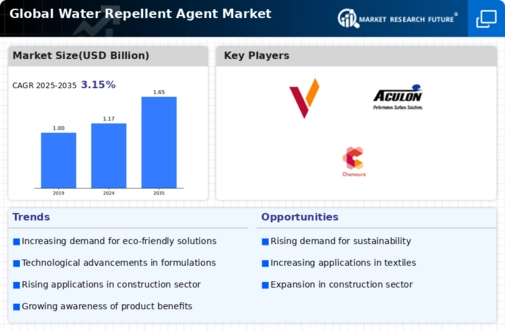Top Industry Leaders in the Water Repellent Agent Market

Water Repellent Agent Market
The Water Repellent Agent (WRA) market, might seem like a niche arena, but beneath the surface lies a vibrant landscape where innovation keeps things anything but dry. From raincoats and tents to textiles and building materials, WRAs find their way into diverse applications, creating invisible shields against water, oil, and stains. But navigating this competitive storm requires strategic expertise, as established giants and nimble startups grapple for market share amidst evolving consumer preferences, technological advancements, and environmental concerns.
Strategies Repelling the Competition:
-
Product Diversification: Leading players like W.L. Gore & Associates, Solvay, and 3M are constantly pushing boundaries, developing specialty WRAs with tailored functionalities for specific materials and applications. Think WRAs for breathable fabrics, self-cleaning surfaces, and durable outdoor gear. -
Sustainability Focus: Environmental consciousness is shaping the market. Players are adopting greener production processes, using bio-based feedstocks, and developing fluorine-free WRAs to minimize environmental impact and cater to sustainability-driven customers. -
Vertical Integration: Securing reliable sources of key raw materials like fluorochemicals and silicones is crucial. Companies like Daikin Industries and Dow Chemical are investing in backward integration to gain control over the supply chain and optimize costs. -
Geographical Expansion: Emerging economies in Asia and Africa present immense growth potential, driven by rising disposable incomes and increasing demand for functional clothing, outdoor gear, and building materials. Companies like Rudolf Chemie and Zhejiang Juhua Chemical are establishing production facilities and forging partnerships in these regions to capitalize on this trend.
Factors Shaping the Market Mosaic:
-
End-User Industries: Textiles and apparel remain the primary drivers, consuming over 60% of global WRA production. Growing urbanization and rising living standards contribute to this demand. -
Consumer Preferences: Increasing demand for multi-functional, durable, and eco-friendly clothing and outdoor gear fuels the adoption of advanced WRAs that offer breathability, stain resistance, and long-lasting performance. -
Regulation and Safety: Stringent regulations on perfluoroalkyl and polyfluoroalkyl substances (PFAS), like REACH in Europe and TSCA in the US, drive the development of safe and fluorine-free WRA alternatives. Companies compliant with these regulations gain a competitive edge. -
Technological Advancements: Research and development efforts are leading to novel WRA formulations, improved application techniques, and the development of self-healing WRAs that regenerate their repellent properties. Early adopters and innovators stand to benefit significantly from these advancements.
Key Companies in the water-repellent agent market include
- Silitex SRL (Italy)
- Elkem Silicones (US)
- Rudolf GmbH (Germany)
- Wacker Chemie AG (Germany)
- NICCA CHEMICAL CO. LTD (Japan)
- BASF SE (Germany)
- Daikin Industries, Ltd (Japan)
- Momentive (US)
- 3M Company (US)
- Evonik Industries AG (Germany)
- Aculon (US)
- The Dow Chemical Company (US)
- Huntsman Corporation (UK)
- The Chemours Company (US)
- Shin-Etsu Chemical Co., Ltd. (Japan)
Recent Developments.
-
September 2023: A fire at a major fluorochemical production facility in Europe disrupts global supply chains, leading to temporary shortages and price hikes for fluorine-based WRAs. -
October 2023: 3M unveils a new line of bio-based and fluorine-free WRAs for sportswear and outdoor apparel, attracting investments from eco-conscious brands. -
November 2023: A consortium of leading research institutions and WRA manufacturers launches a collaborative project to develop durable and environmentally friendly WRAs for sustainable building materials. -
December 2023: The WRA market exhibits cautious optimism for steady growth in 2024, driven by increasing demand for functional fabrics, sustainability initiatives, and technological advancements. However, potential regulatory changes and resource availability require monitoring.









